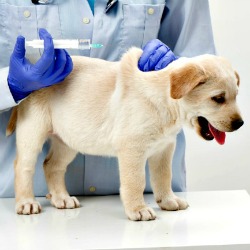About Parvo in Puppies
Canine Parvovirus (aka Parvo) is an extremely contagious virus that mainly targets the gastrointestinal tract of puppies and dogs. Parvo in puppies is severe and potentially deadly.
Unvaccinated puppies, and puppies and young dogs who are partially vaccinated are most at risk.
The stools of infected dogs are the primary source of infection, and it can also be spread through direct dog to dog contact.
Left untreated, parvo will kill 90% or more of it's young victims.
The mortality rate for puppies (and dogs) who receive full veterinary care is somewhere around 10%. This means that approximately 90% of puppies who receive prompt diagnosis and veterinary care survive (see statistics and clinical information here)
This figure may vary due to the strain of parvovirus involved and how quickly the diagnosis is made and treatment started. For some strains of parvo, and if diagnosis is made and treatment started after a puppy is already very sick, the mortality rate can be up to 30%.
Very young puppies (less than eight weeks of age) are also at a higher risk of dying from parvo even with prompt treatment.
Adult dogs, even if unvaccinated, have better odds of surviving parvo than puppies but are still at risk of serious illness or death.
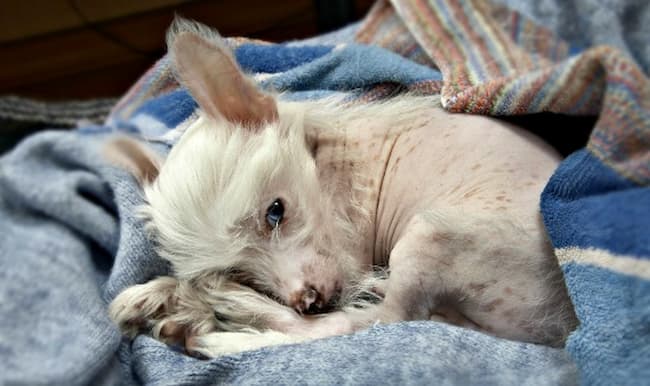
- How can a puppy get parvo?
- Symptoms of Canine Parvovirus
- Parvo treatment
- How to prevent Parvo
- Parvo in puppies FAQ's
How Do Puppies Get Parvo?
Puppies and dogs contract this deadly virus by ingesting, the feces (or vomit) of an infected dog. Just one stool can be the source of infection for multiple dogs/puppies. Any trace of the virus on paws, coat etc. is likely to be licked at some point, so the only way to avoid ingestion is to avoid contamination.
A puppy infected with parvo can start to shed active viral particles four to five days after being infected, and often before symptoms are first noticed, so just because a puppy or dog appears healthy, it doesn't mean that they aren't already carriers of (of infected with) canine parvovirus.
A dog or puppy who has recovered from parvo continues to shed live viral cells in feces for at least 10-14 days after recovery.
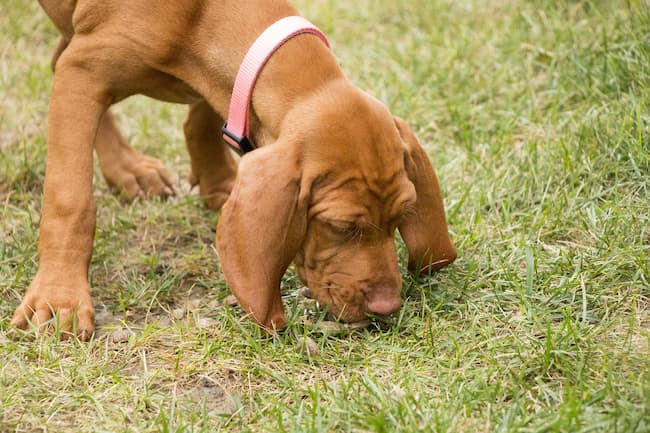
Parvovirus is extremely contagious and the viral particles are very hardy, being able to withstand heat, cold, rain and the use of many cleaning products.
Clinical Signs of Parvovirus
The parvo incubation period is between 3 and 14 days from time of exposure and most puppies will begin to show symptoms between days 5 and 8. Between days 1 and 5 a puppy may, or may not, show any signs of illness even though the virus in in his blood stream.
However, once it reaches his intestines the virus causes severe inflammation and begins to damage the lining of the puppy's gastrointestinal tract, particularly the small intestines. Sometimes, certain strains of parvovirus infection can also affect the bone marrow, lymph nodes, spleen, lymphatic system and heart.
The most common symptoms of Parvo in puppies include:
- Fatigue
- Loss of appetite
- Severe and recurrent vomiting
- Severe and recurrent diarrhea (bloody diarrhea is classis for parvo)
- Fever (over 103F)
- Low body temperature (below 99F)
A generalized fatigue accompanied by loss of appetite are the first signs of parvo. Repeated and increasingly severe vomiting, closely followed by repeated and increasingly severe diarrhea come next, and this is when pet owners often first realize something is wrong.
Parvo diarrhea becomes increasingly watery very quickly, is often explosive, foul smelling, and may contain mucus or blood (either as red, or black, streaks). Because of the effects of parvovirus on the GI tract, a pup with parvo is unable to keep food, or even water, down and is at immediate risk of severe dehydration due to fluid loss.
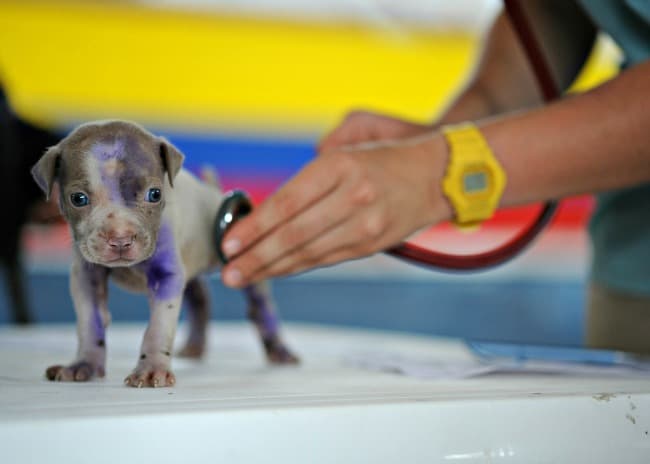
Because parvo is so aggressive and severe, it's vital to get a puppy veterinary care as soon as you notice something is wrong. The first 48 to 72 hours are the most critical, and infected puppies are likely to die within that timeframe if left untreated. It's not unheard of for a puppy to die within 24 hours of onset of vomiting/diarrhea.
This means a prompt diagnosis is vital and the best way to give a puppy a fighting chance against this deadly disease. Diagnosing canine parvovirus is quick and simple, and involves looking for viral particles in the stool or antibodies in the bloodstream. A low white blood cell count is another indication of parvo.
Some dog breeds are at an increased risk of contracting parvo, these include
- Rottweilers
- Doberman Pinschers
- Pitbull Terriers
- American Staffordshire Terriers
How To Treat Parvo in Puppies
Because parvo is a virus there is no cure, but supportive treatment and appropriate measures to avoid secondary bacterial infections (which are very common with parvo) can increase the survival rate from approx. 10% to as high as 90%... IF GIVEN EARLY ENOUGH.
The importance of early intervention and veterinary treatment can't be overstated, and at home treatment is not recommended unless unavoidable, and even then you will need medication and care instructions from your veterinarian.
Round the clock monitoring and care at a veterinary hospital or clinic is the best, and safest, option for all.
- Veterinary Treatment for parvo generally includes
- Intravenous fluids to protect against dehydration
- Intravenous antibiotics to prevent secondary infection
- Anti-nausea medication
- Anti-inflammatories to reduce inflammation
- Anti-spasmodics to reduce stomach cramps
- IV nutrients and/or vitamins
Puppies with severe cases may need intensive care because the virus is attacking their heart muscles, bone marrow or other organs.
Very young puppies, puppies from the higher-risk breeds, those diagnosed late or those with other health or immune system problems may also need additional procedures such as blood transfusions, and sometimes aggressive treatment for secondary infections.
Unfortunately even with the best of care, about 10% of puppies who catch parvo will still die, some from septic shock, others from organ failure (including heart failure), secondary infections and more.
Canine Parvo is devastating to a puppy's body and immune system and the recovery period can be significant for some, depending on how severe the infection was.
Puppies are generally somewhere back to normal in between two or three weeks, but it can take considerably longer for them to regain their weight, strength and energy. Full recovery could take as long as one to two months.
Parvo Prevention
The best way to prevent a puppy, or dog of any age, from catching Parvovirus is to have him vaccinated against it. Parvo is a core vaccine and is on the recommended vaccination schedule for puppies.
To learn more about vaccinating puppies in general, and the Canine Parvovirus vaccine specifically check out THIS PAGE.
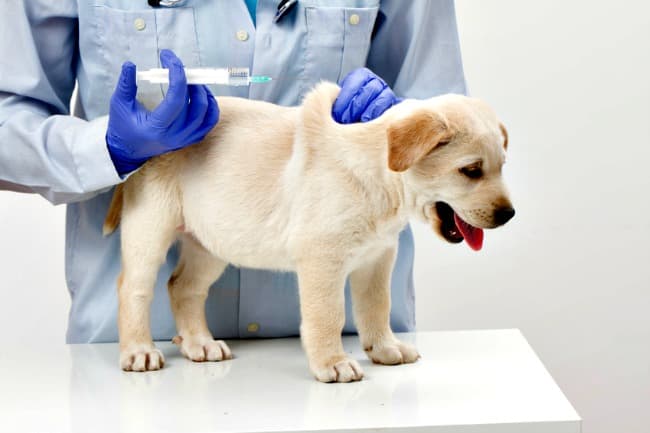
Parvo is such a contagious, dangerous and devastating illness, that it's vitally important to protect your puppy with proper vaccination.
It's equally important to make absolutely certain that he doesn't get any exposure to public areas where other dogs may have been, or spend any time with, or around, dogs who aren't fully vaccinated, until he's had all his parvo shots.
Because parvo virus is so resilient and can survive extreme temperatures and many household cleaning products, the best way to effectively kill it is to use an approx. 1:30 solution of chlorine bleach and water (one part bleach to 30 parts water).
For quick reference this equates to approx 1/2 cup of chlorine bleach to one gallon of water, (or 133 ml of chlorine bleach to 4 liters of water).
You can use this solution to sanitize floors, walls, food and water bowls (rinse thoroughly with clean water after santizing), cement and any other hard surface.
Parvo viral cells can remain in dirt/soil/grass for years, pouring this bleach solution over surfaces like this can help kill these cells but there are no guarantees that you'll get them all.
Going forward, any area of your yard that a parvo infected puppy pooped in while sick, is a risk to unvaccinated puppies or dogs.
Parvo and Puppies FAQs
Can puppies get parvo from grass?
Yes, puppies can get parvo from being in contact with grass where an infected puppy or dog has pooped or vomited. If they get any poop or vomit on them, and lick or ingest it, they can get catch parvo from that.
Can a puppy get parvo after two shots?
Short answer is yes. Although vaccination is the best protection against canine parvovirus, occasionally even fully vaccinated puppies can get sick. A puppy can get parvo after the first, second, or third shots. It's often recommended that breeds at high risk of parvo (such as Rottweilers, Dobermans and some bully breeds) get a fourth parvo shot at approx. 16 weeks as additional protection.
Does my puppy have parvo?
It's impossible to be certain whether your puppy has parvo or not without a stool sample being tested or a blood test being conducted by a veterinarian. HOWEVER, any puppy or young dog (especially unvaccinated or partially vaccinated ones) who have repeated vomiting and/or diarrhea should be tested for parvo. It's always better to be safe than sorry when it comes to parvo infection.
What to do if a puppy has parvo?
If you even have a suspicion that your puppy may have parvo you need to have him/her evaluated by a veterinarian right away. Immediately. Even if it means a visit to a 24 hour animal clinic or hospital. Parvo is aggressive and deadly, and even a 12 hour wait for your vet to open could cost a puppy his/her life. If your puppy gets a positive diagnosis of canine parvovirus, following your veterinarians advice and treatment protocol is the best way to help ensure he/she becomes a parvo survivor.
Can dogs get parvo twice?
Once a dog has had parvo it has a natural immunity which should be lifelong. There are always exceptions to any rule and it's possible a dog can catch parvo a second time, especially if exposed to a different strain than the one he/she recovered from, however this is very rare.
How do I know if my puppy will survive parvo?
There are no guarantees any puppy will survive parvo, even when treated by a veterinarian. However the only way to increase a puppy's chance of making it through is to get him/her diagnosed, and get treatment started, as early as possible.
What are the stages of parvo?
The basic stages of parvovirus are the same as for most other illnesses
- Exposure
- Incubation
- Symptoms
- Diagnosis
- Treatment
- Recovery
The active phase of the illness is from the time the first symptoms appear until they resolve , and covers the symptomatic, diagnostic, treatment and recovery stages. The first 48-72 hours after onset of symptoms is the most critical period, and if a puppy is going to die it's most likely to happen during this period.
Puppies who survive the first four days have a good chance of making a full recovery, although there are no guarantees and sometimes they can worsen again, or die suddenly even after appearing to rally. Parvo really is a horrible and aggressive disease.
What to feed a puppy with parvo?
During the most intense phase of parvo virus infection puppies are unable to hold down food, or water.
Puppies who get past this stage, are no longer vomiting and who are beginning to recover need a bland diet to allow their traumatized digestive systems readjust to solid food. The most popular bland diet for puppies and dogs consists of plain, boiled, white rice with some boiled chicken breast added.
If you need to keep a puppy on a bland diet for more than a few days you can substitute boiled ground beef (yes, boiled in a pot of water and then strained) for the chicken. A little sodium free chicken broth can also be added to this mixture once the digestive system starts to recover.
Feeding a puppy recovering from parvo a bland diet for at least a week is recommended by veterinarians. After that, and depending on how well the puppy is recovering, familiar dog food can be reintroduced slowly.
You Might Also Like:
- Home
- Is My Puppy Sick?
- Parvo in Puppies
